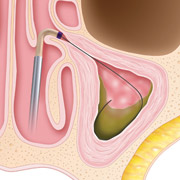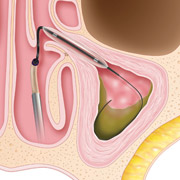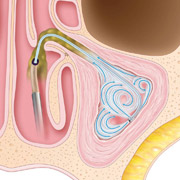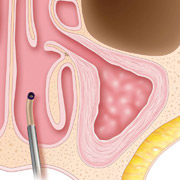
Sinusitis affects 37 million people each year, making it one of the most common health problems in the U.S. It is more prevalent than heart disease and asthma and has a greater impact on quality of life than chronic back pain or congestive heart failure.
When you have acute or chronic sinusitis, the mucous membranes of your nose, sinuses and throat become inflamed, possibly from a pre-existing cold or allergies. Swelling obstructs the sinus openings and prevents normal mucus drainage, causing mucus and pressure to build up. Symptoms include: drainage of a thick, yellow or greenish discharge from the nose or down the back of the throat; nasal obstruction or congestion; tenderness and swelling around the eyes, cheeks, nose and forehead; and/or a reduced sense of smell and taste.
Many sinusitis cases are acute, but if sinusitis symptoms last longer than 12 weeks, it could be chronic sinusitis. Structural issues such as blockage of the sinus opening can also lead to chronic sinusitis.
Balloon Sinuplasty is a breakthrough procedure that relieves the pain and pressure associated with chronic sinusitis. It is used by surgeons to safely and effectively treat chronic sinusitis patients who are not responding well to medications such as antibiotics, nasal steroids, or over‐the‐counter (OTC) drugs, and are seeking relief from uncomfortable and painful sinusitis symptoms.
Similar to how angioplasty uses balloons to open blocked arteries, Balloon Sinuplasty, a system of FDA‐cleared, catheter‐based instruments, opens blocked sinuses.
The procedure is less invasive than traditional sinus surgery. It allows most patients to return to normal activities quickly.
With Balloon Sinuplasty, a specially‐designed catheter is inserted into the nose to reach the inflamed sinus cavity. A small balloon is slowly inflated, which widens and restructures the walls of the sinus passage, helping to drain mucus from the blocked sinus and restore normal sinus drainage without cutting and with minimal bleeding. This approach also preserves the natural structure of the sinuses.
To find out if you are a candidate for Balloon Sinuplasty, please schedule your consultation.
Make An AppointmentStep 1. A balloon catheter is inserted into the inflamed sinus.

Step 2. The balloon is inflated to expand the sinus opening.

Step 3. Saline is sprayed into the inflamed sinus to flush out the pus and mucus.

Step 4. The system is removed, leaving the sinuses open.

Balloon Sinuplasty is performed under general anesthesia in an outpatient setting; however, some surgeons are choosing to treat certain patients in their office under local anesthesia. The reported complication rate for Balloon Sinuplasty is low.
Patients who suffer from chronic sinusitis and are not responding well to medications may benefit from seeing one of our ENT Physicians of Mississippi who performs Balloon Sinuplasty to determine if the procedure is right for them. Most insurance companies and Medicare provide coverage for Balloon Sinuplasty.
Balloon Sinuplasty has been used to treat more than 160,000 patients since receiving FDA clearance.
To find out if you are a candidate for Balloon Sinuplasty, please schedule your consultation.
Make An Appointment© ENT Physicians of North Mississippi - All Rights Reserved - Managed by Practis